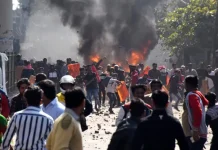Markets around the world reacted seismically on Thursday as Russian forces invaded Ukraine, tipping a long diplomatic standoff into a military conflict.
Russian President Vladimir Putin declared a “special military operation” early Thursday morning, two days after formally recognizing two breakaway regions in eastern Ukraine as independent. Reports soon emerged of explosions in the capital Kyiv and other cities around the country as missiles were launched, while more Russian troops arrived on the southern coast of Ukraine.
The US and Europe have pledged to hold Moscow accountable, with more damaging and substantial sanctions against Russia now being readied by western powers.
European markets fell sharply, with the continental Stoxx 600 index sliding more than 3 percent to its lowest point of the year. Germany’s DAX shed 4 percent.
Shares in Asia-Pacific plummeted across the board, led by a 3.2 percent decline for Hong Kong’s Hang Seng index.
Stocks also sank stateside, with the Dow Jones Industrial Average losing more than 600 points. The tech-heavy Nasdaq Composite, meanwhile, dropped 0.4 percent while the S&P 500 slid 1.2 percent.
Meanwhile, oil prices spiked, sending international benchmark Brent crude above $100 per barrel for the first time since 2014. As of around 11:50 a.m. ET, Brent futures were trading 6.7 percent higher at $103.25 per barrel, while US crude futures were up 4.7 percent at $96.45 per barrel.
The Russian ruble initially sank to an all-time low against the dollar, with the greenback gaining more than 10 percent against the Russian currency to take it above 89.89 to the dollar, before recovering some of its losses. The ruble was last trading at 87.04 to the dollar. Natural gas prices also popped.
The Moscow Exchange briefly suspended trading on all of its markets early on Thursday morning as Russian stocks nosedived. It recommenced at 10 a.m. Moscow time. The MOEX Russia Index was last seen down 33.3 percent and the RTS Moscow index was down 39 percent.
Spot gold jumped to its highest level in more than a year before paring its gains. It was last up nearly 0.8% at $1,922.30 per ounce, as investors sought traditional safe havens. Wheat futures spiked to their highest level since 2012, and soybean futures notched an all-time high.
Global investors are contending not only with uncertainty over the duration and extent of the ensuing conflict but also by the potential supply shortages, worsening inflation due to surging energy prices, slowing economic growth, and the increased risk of policy errors from central banks caught in a unique conundrum.
“Heightened volatility on the escalation of the conflict shows markets had not fully priced in the likelihood of deeper conflict,” said Mark Haefele, chief investment officer at USB Global Wealth Management. “We expect continued volatility in the near term as leaders calibrate and announce their response to this escalation.”
UBS noted that Russia has a strong commercial interest in continuing to sell its energy and commodity exports into Europe, with the EU accounting for 36.5% of all Russian imports and 37.9% of exports in 2020. The Swiss lender’s strategists suggested that the weight of this trade relationship could mitigate the risk of a long-lasting military engagement.
However, UBS offered investors five action points for investors to navigate the current period of uncertainty: keep a diversified portfolio, use commodities as a geopolitical hedge, position for U.S. dollar strength, buy the winners from global growth, and build up some defense.
Goldman Sachs analysts noted on Thursday that the crisis had pushed the Federal Reserve’s risk index to a very high level, though direct effects on the U.S. economy will be limited relative to Europe, which is more susceptible to trade disruptions, higher energy prices and tighter financial conditions.









